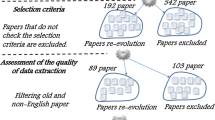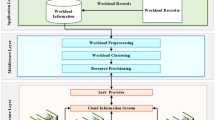Abstract
With the development of multimedia application and services, the multimedia technology has already permeated each aspect of our life. Multimedia cloud is used for processing multimedia services. However due to huge data volume, high concurrency, strict real-time, resource scheduling for content dissemination in multimedia cloud still remain challenges. In order to increase the user satisfaction and decrease completion time of content dissemination, the resource scheduling for content dissemination in multimedia cloud is proposed in this paper. The multimedia jobs are clustered according to user expectation and job complexity. The job with highest priority will be executed first. Moreover, considered multimedia task types and the impact of stragglers, the multimedia task scheduling based on task types and node workload is presented, which is a time-efficient scheduling approach. The experiments are conducted and the experiment results show that the job clustering algorithm-based user expectation and job complexity in multimedia cloud has better user satisfaction and shorter completion time, while the multimedia task scheduling based on task types and node workload can reduce completion time and achieve load-balancing.















Similar content being viewed by others
References
Wen H, Chuang L, Yang Y (2012) MediaCloud: a new paradigm of multimedia computing. Ksii Trans Internet Inf Syst 2(2):81–94
Zhu W, Luo C, Wang J et al (2011) Multimedia cloud computing. IEEE Signal Process Mag 28(3):59–69
Tang S, Jaho E, Stavrakakis I (2011) Modeling gossip-based content dissemination and search in distributed networking. Comput Commun 34(6):765–779
Liu S, Cheng X, Lan C, Weina F, Zhou J, Li Q, Gao G (2013) Fractal property of generalized M-set with rational number exponent. Appl Math Comput 220(4):668–675
Liu S, Cheng X, Weina F, Zhou Y, Li Q (2014) Numeric characteristics of generalized M-set with its asymptote. Appl Math Comput 243:767–774
Thilakarathna K, Seneviratne A, Viana AC et al (2014) User generated content dissemination in mobile social networks through infrastructure supported content replication. Pervasive Mob Comput 11(2):132–147
Liu M, Liu S, Weina FU, Zhou J (2015) Distributional escape time algorithm based on generalized fractal sets in cloud environment. Chin J Electron 24(1):124–127
Liu S, Zhang Z, Qi L, Ma M (2015) A fractal image encoding method based on statistical loss used in agricultural image compression. Multimed Tools Appl 75(23):15525–15536
Dong B, Li X, Wu Q et al (2012) A dynamic and adaptive load balancing strategy for parallel file system with large-scale I/O servers. J Parallel Distrib Comput 72(10):1254–1268
Satish P, Chronopoulos AT (2011) Game-theoretic static load balancing for distributed systems. J Parallel Distrib Comput 71(4):537–555
Grosu D, Chronopoulos AT, Leung M-Y (2008) Cooperative load balancing in distributed systems. Concurr Comput Pract Exp 20(16):1953–1976
Xueyan T, Chanson ST (2000) Optimizing static job scheduling in a network of heterogeneous computers. In: Proceeding of International Conference on Parallel Processing. IEEE Computer Society Press, pp 373–382
Hjalmtysson G, Whitt W (1998) Periodic load balancing. Queueing Syst 30(1–2):203–250
Shojafar M, Javanmardi S, Abolfazli S et al (2015) FUGE: a joint meta-heuristic approach to cloud job scheduling algorithm using fuzzy theory and a genetic method. Clust Comput 18(2):829–844
Hassan MM (2014) Cost-effective resource provisioning for multimedia cloud-based e-health systems. Multimed Tools Appl 74(14):5225–5241
Hui W, Zhao H, Lin C et al (2011) Effective load balancing for cloud-based multimedia system. In: Proceeding of 2011 International Conference on Electronic and Mechanical Engineering and Information Technology. IEEE Computer Society Press, pp 165–168
Lin C-C, Chin H-H, Deng D-J (2014) Dynamic multiservice load balancing in cloud-based multimedia system. IEEE Syst J 8(1):225–234
Babu LD, Venkata KP (2013) Honey bee behavior inspired load balancing of tasks in cloud computing environments. Appl Soft Comput 13(5):2293–2303
Grosu D, Chronopoulos AT (2005) Non-cooperative load balancing in distributed systems. J Parallel Distrib Comput 65(9):1022–1034
Yu H-Y, Huang J-C, Chen J-J (2015) A hierarchical reliability-driven scheduling for cloud video transcoding. In: Proceeding of 2015 International Conference on Machine Learning and Cybernetics (ICMLC). IEEE Computer Society Press, pp 456–461
Dai X, Wang X, Liu N (2017) Optimal scheduling of data-intensive applications in cloud-based video distribution services. IEEE Trans Circuits Syst Video Technol 27(1):73–83
Kim J, Caire G, Molisch AF (2016) Quality-aware streaming and scheduling for device-to-device video delivery. IEEE/ACM Trans Netw 24(4):2319–2331
Wu M-Y, Sujan M, Wei S (2006) Scheduled video delivery—a scalable on-demand video delivery scheme. IEEE Trans Multimed 8(1):179–187
Li L, Ma X, Huang Y (2013) CDN cloud: a novel scheme for combining CDN and cloud computing. In: International Conference on Measurement, Information and Control, pp 687–690
Ioannidis S, Chaintreau A, Massoulie L (2009) Optimal and scalable distribution of content updates over a mobile social network. IEEE INFOCOM 2009:1422–1430
Felice MD, Cerqueira E, Melo A et al (2015) A distributed beaconless routing protocol for real-time video dissemination in multimedia VANETs. Comput Commun 58(3):40–52
Liu S, Fu W, He L, Zhou J, Ma M (2017) Distribution of primary additional errors in fractal encoding method. Multimed Tools Appl 76(4):5787–5802
Li Y, Cheng AMK (2015) Transparent real-time task scheduling on temporal resource partitions. IEEE Trans Comput 65(5):1646–1655
Zhu X, Zhu J, Ma M, Qiu D (2010) SAQA: a self-adaptive QoS-aware scheduling algorithm for real-time tasks on heterogeneous clusters. IEEE/ACM Int Conf Clust 2010:224–232
Sun X, He C, Lu Y (2012) ESAMR: an enhanced self-adaptive MapReduce scheduling algorithm. In: 2012 IEEE 18th International Conference on Parallel and Distributed Systems, pp 148–155
Liu S, Pan Z, Weina F, Cheng X (2017) Fractal generation method based on asymptote family of generalized Mandelbrot set and its application. J Nonlinear Sci Appl 10:1148–1161
Tian C, Zhou H, He Y et al (2009) A dynamic MapReduce scheduler for heterogeneous workloads. In: Eighth International Conference on Grid and Cooperative Computing. IEEE, pp 218–224
Youku website (2016) http://www.youku.com/
Yang SJ, Chen YR (2015) Design adaptive task allocation scheduler to improve MapReduce performance in heterogeneous clouds. J Netw Comput Appl 57:61–70
Pop F, Dobre C, Cristea V et al (2015) Deadline scheduling for aperiodic tasks in inter-cloud environments: a new approach to resource management. J Supercomput 71(5):1754–1765
Acknowledgements
The authors thank the editors and the anonymous reviewers for their helpful comments and suggestions. The work was supported by the National Natural Science Foundation (NSF) under Grants (Nos. 61672397, 61472294), the Jiangsu Key Laboratory of Image and Video Understanding for Social Safety (Nanjing University of Science and Technology), Grant No. 30916014107, Key Laboratory of Spatial Data Mining & Information Sharing of Ministry of Education, Fuzhou University (No. 2016LSDMIS05), Program for the High-end Talents of Hubei Province. Any opinions, findings and conclusions are those of the authors and do not necessarily reflect the views of the above agencies.
Author information
Authors and Affiliations
Corresponding author
Rights and permissions
About this article
Cite this article
Li, C., Zhu, L., Liu, Y. et al. Resource scheduling approach for multimedia cloud content management. J Supercomput 73, 5150–5172 (2017). https://doi.org/10.1007/s11227-017-2074-y
Published:
Issue Date:
DOI: https://doi.org/10.1007/s11227-017-2074-y




